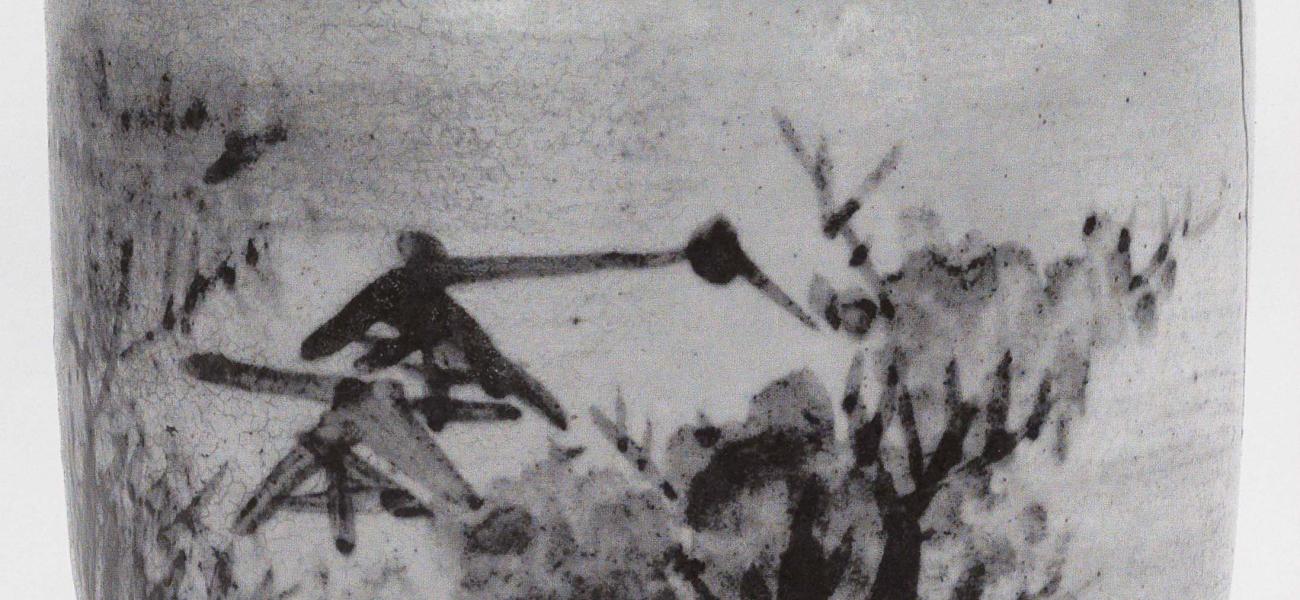A Kenzan Incense Burner
This small, cylindrical vessel is neatly thrown from off-white, fine-grained stoneware clay. The shape resembles a tea bowl, but the absence of glaze on most of the interior indicates that it is an incense burner. A pinch of ground fragrant woods and resins would be sprinkled onto a live coal bedded in sieved ash half-filling the vessel.
Painted in an impure cobalt that yields tones from blue-gray to black, the decoration has two components. One side presents the roofline of a building hidden in trees and enveloped in autumn mist or twilight. The opposite side bears a poem:
Indifferent to expense, they built
a lofty golden terrace;
Settled here in seclusion, my mind
has turned to ashes.
Although each line of the Chinese-style poem contains seven characters, to suit the shape of this vessel the calligrapher divided the characters into three vertical columns (brushing them from right to left) of five, five, and four characters. The knowledgeable reader would enjoy the disjunction between the conventional arrangement and this design.
The poem refers to a well-known composition by an ancient Chinese writer, Chen Ziang (661-702), which describes a journey to the ruins of a former kingdom. The "golden pavilion," built by the emperor as a gathering place for the ablest persons of the realm, had been destroyed by warfare. The poem - seemingly spoken by someone who has abandoned a public career to settle in the ruins - reflects on the evanescence of grand ambitions, both imperial and personal.
This incense burner was made in a workshop run by Ogata Kenzan (1663-1743), son of a prosperous merchant family in Kyoto. Kyoto kilns had been making stoneware decorated with landscape motifs for about a century when Kenzan entered the field. Still older precedents were to be found in Chinese porcelain incense burners from the 16th century, decorated in cobalt with motifs of pavilions among clouds.
By adding words to his image, Kenzan transformed the reference of this conventional decoration, embedding it in history and deepening its resonance. The combination of poem and image resembles the painting and inscription found on a handscroll. The painting - no longer just a "design" - uses the abbreviated "splashed ink" mode originating in Chinese ink painting; the intentional choice of impure cobalt pigment replicates the tonalities of ink. Finally, Kenzan adds another type of word: his own name. His signature, in the last two lines at the left of the poem, reads: "Respectfully written by Shinsei, Hermit Potter of Northwest Mountains." The two painted seals, imitating those an inscriber would impress, read "Veneration of Antiquity" and "Potter Hermit." This signature is in its logical place insofar as the overall composition resembles a painting scroll with colophon, but in fact Kenzan succeeds in moving his potter's mark from the hidden base of the vessel to the very climax of its decoration. Moreover, he designates as his own the distinctive calligraphy of the poem - and perhaps even the poem. (The painting was probably executed by a trained artist employed in Kenzan's studio.)
Kenzan's embellishment of this simple vessel form draws on his knowledge of Chinese painting models and literary classics. Although in real life he was a successful businessman managing a productive pottery studio situated in the center of Kyoto, here he adopted the pose of the recluse, the "hermit potter" - in itself a Chinese trope familiar to him through his education. This vessel would have found a place in the reception room or study of a man with similar taste and experience. Lighting the incense - sending up the curl of perfumed smoke - would have brought to life the hut built in the ashes of the "golden terrace."


